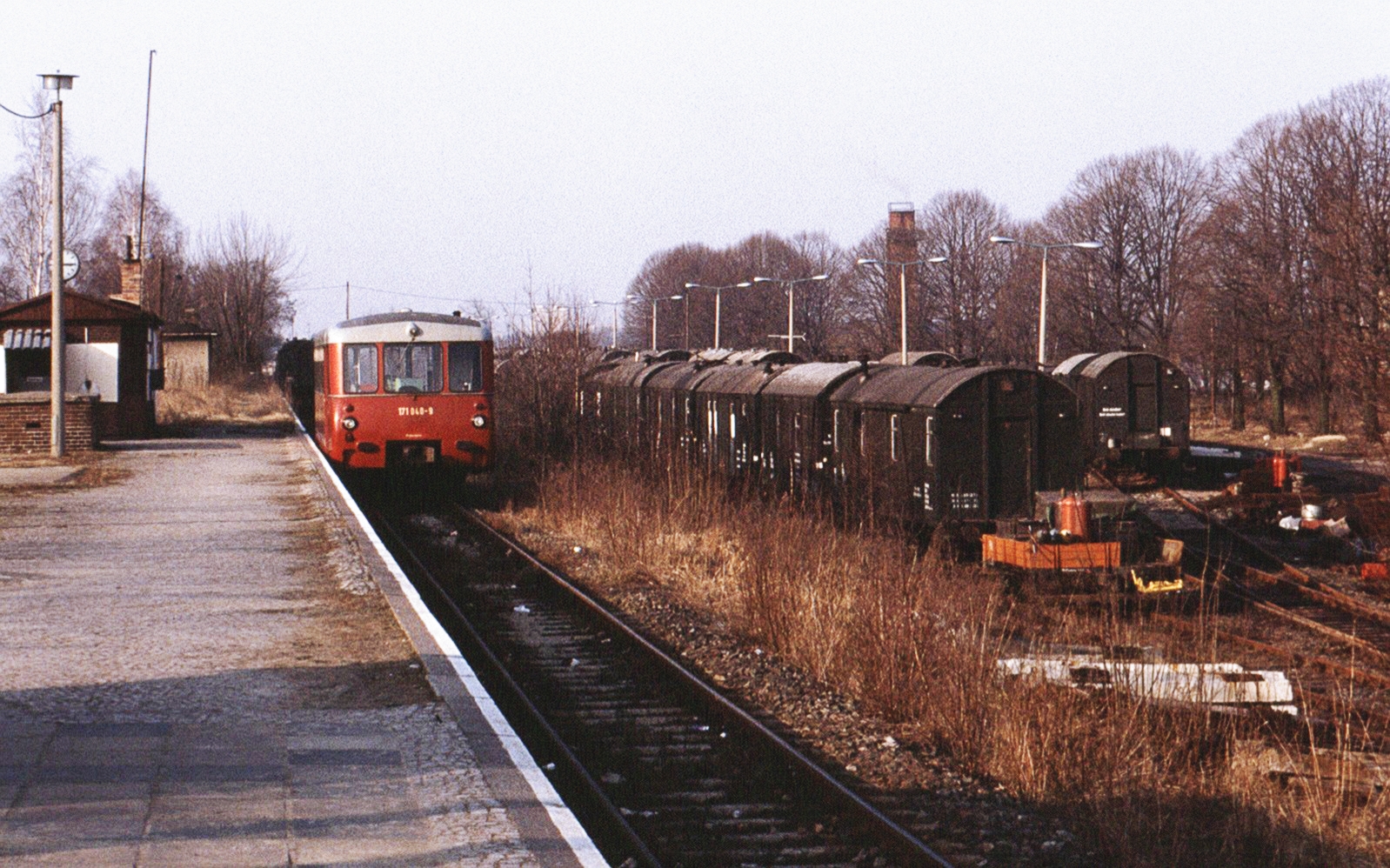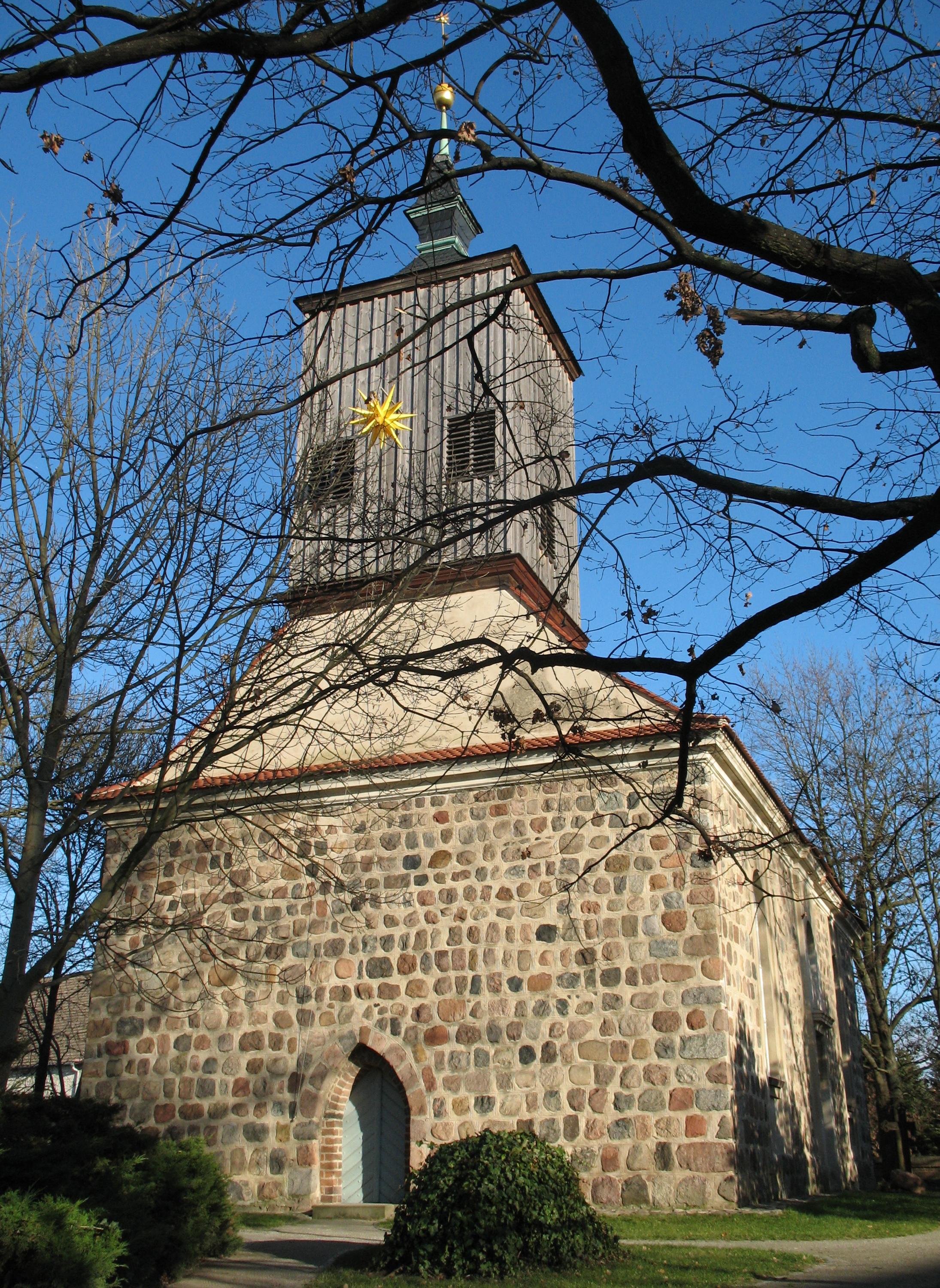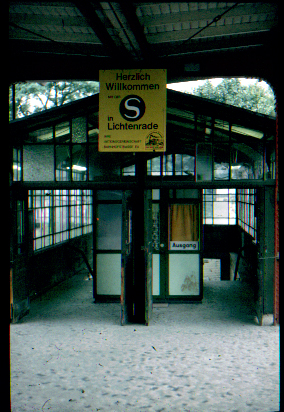|
Mahlow Station
Mahlow station is a station in the town of Mahlow in the municipality of Blankenfelde-Mahlow in the district of Teltow-Fläming in the German state of Brandenburg. It is on the Berlin–Dresden suburban line and is served by Berlin S-Bahn line S2. Location The station is located in the centre of the town of Mahlow at kilometre 16.8 of the Berlin–Dresden railway, a few hundred metres inside the Berlin Outer Ring (''Berliner Außenring'', BAR). History The Mahlow station was opened along with the Dresden Railway on 17 June 1875. Electric S-Bahn trains ran to Mahlow from 15 May 1939 and the S-Bahn connection was extended to Rangsdorf in October 1940. The station building was hit and badly damaged in air raids in 1943. S-Bahn traffic from the north was cut off by the construction of the Berlin Wall in August 1961. A shuttle service was operated south to Rangsdorf, but it was closed in September 1961. Instead an existing service between Rangsdorf and Wünsdorf was extended to ... [...More Info...] [...Related Items...] OR: [Wikipedia] [Google] [Baidu] |
Blankenfelde-Mahlow
Blankenfelde-Mahlow is a municipality in the Teltow-Fläming district of Brandenburg, Germany. It is situated approximately south of Berlin. History The municipality shared its borders with the former West Berlin, and so during the period 1961-1990 it was separated. Blankenfelde Blankenfelde was first mentioned in documents in 1375. However, a substantial part of this district, the so-called Gagfah settlement, did not develop until the 1930s, after the Süd-Berlin Bodenaktiengesellschaft had acquired and parceled out the area. As a result, the population increased significantly - from 766 inhabitants in 1930 to 6228 inhabitants in 1939. Mahlow Mahlow was first mentioned in documents in 1287. After the place had received a station in 1875, the immigration of wealthy Berliners. Its constituency is under Teltow from 1945 until its dissolution in 1952. As early as 1950, the community Glasow was merged with the community Mahlow. The construction of the Berlin Wall from 13 August ... [...More Info...] [...Related Items...] OR: [Wikipedia] [Google] [Baidu] |
Wünsdorf-Waldstadt Station
Wünsdorf-Waldstadt (german: Bahnhof Wünsdorf-Waldstadt) is a railway station in the town of Wünsdorf, Brandenburg, Germany, on the Berlin–Dresden railway The Berlin–Dresden railway is a double track, electrified main line railway in the German states of Berlin, Brandenburg and Saxony, which was originally built and operated by the ''Berlin-Dresden Railway Company'' (''Berlin-Dresdener Eisenbahn- ..., with services operated by Deutsche Bahn. Train services The station is served by the following services: *Regional services ''Rostock / Stralsund – Neustrelitz – Berlin – Wünsdorf-Waldstadt – Elsterwerda'' *Regional servic ... [...More Info...] [...Related Items...] OR: [Wikipedia] [Google] [Baidu] |
Railway Stations In Brandenburg
Rail transport (also known as train transport) is a means of transport that transfers passengers and goods on wheeled vehicles running on rails, which are incorporated in Track (rail transport), tracks. In contrast to road transport, where the vehicles run on a prepared flat surface, rail vehicles (rolling stock) are directionally guided by the tracks on which they run. Tracks usually consist of steel rails, installed on Railroad tie, sleepers (ties) set in track ballast, ballast, on which the rolling stock, usually fitted with metal wheels, moves. Other variations are also possible, such as "slab track", in which the rails are fastened to a concrete foundation resting on a prepared subsurface. Rolling stock in a rail transport system generally encounters lower friction, frictional resistance than rubber-tyred road vehicles, so passenger and freight cars (carriages and wagons) can be coupled into longer trains. The rail transport operations, operation is carried out by a ... [...More Info...] [...Related Items...] OR: [Wikipedia] [Google] [Baidu] |
Berlin S-Bahn Stations
Berlin ( , ) is the capital and largest city of Germany by both area and population. Its 3.7 million inhabitants make it the European Union's most populous city, according to population within city limits. One of Germany's sixteen constituent states, Berlin is surrounded by the State of Brandenburg and contiguous with Potsdam, Brandenburg's capital. Berlin's urban area, which has a population of around 4.5 million, is the second most populous urban area in Germany after the Ruhr. The Berlin-Brandenburg capital region has around 6.2 million inhabitants and is Germany's third-largest metropolitan region after the Rhine-Ruhr and Rhine-Main regions. Berlin straddles the banks of the Spree, which flows into the Havel (a tributary of the Elbe) in the western borough of Spandau. Among the city's main topographical features are the many lakes in the western and southeastern boroughs formed by the Spree, Havel and Dahme, the largest of which is Lake Müggelsee. Due to its location ... [...More Info...] [...Related Items...] OR: [Wikipedia] [Google] [Baidu] |
List Of Railway Stations In Brandenburg
This list covers all passenger railway stations and halts in Brandenburg that are used by scheduled and seasonal traffic. Description The list is organised as follows: * ''Name'': the current name of the station or halt. * ''Urban/Rural county (''Kreis'')'': This column shows the county in which the station is located. The abbreviations used correspond to those used for German car number plates. The individual counties in Brandenburg are: * Barnim (''BAR'') * Brandenburg (Havel) (''BRB'') * Cottbus (''CB'') * Dahme-Spreewald (''LDS'') * Elbe-Elster (''EE'') * Frankfurt (Oder) (''FF'') * Havelland (''HVL'') * Märkisch-Oderland (''MOL'') * Oberhavel (''OHV'') * Oberspreewald-Lausitz (''OSL'') * Oder-Spree (''LOS'') * Ostprignitz-Ruppin (''OPR'') * Potsdam (''P'') * Potsdam-Mittelmark (''PM'') * Prignitz (''PR'') * Spree-Neisse (''SPN'') * Teltow-Fläming (''TF'') * Uckermark (''UM'') * ''Railway operator'': Several stations in Brandenburg are run by the ''Verkehrsverbund Ber ... [...More Info...] [...Related Items...] OR: [Wikipedia] [Google] [Baidu] |
List Of Railway Stations In Berlin
This list covers the railway stations in the Berlin area. These include both passenger stations and marshalling yards, but not goods stations. Because the Berlin S-Bahn network has expanded to include stations in the state of Brandenburg, the table shows only those stations lying within the Verkehrsverbund Berlin-Brandenburg's present-day Berlin ABC fare zones (i.e. those up to about 15 kilometres from the Berlin city boundary), and those formerly served by Berlin's suburban services. The latter ran out beyond the capital's boundaries to the next largest towns along the main and branch lines. The farthest towns on the lines covered here are listed below: Rüdnitz ( Stettin Railway) – Werneuchen (Wriezen Railway) – Strausberg (Prussian Eastern Railway) – Fürstenwalde (Lower Silesian-Märkisch Railway) – Kablow ( Königs Wusterhausen–Grunow) – Königs Wusterhausen ( Görlitz Railway) – Mittenwalde ( Neukölln–Mittenwalde railway) – Wünsdorf ( Dresden ... [...More Info...] [...Related Items...] OR: [Wikipedia] [Google] [Baidu] |
Bernau Bei Berlin Station
Bernau bei Berlin (in German ''Bahnhof Bernau bei Berlin'', simply known as Bernau) is a railway station in the city of Bernau bei Berlin, Germany. It is served by the Berlin S-Bahn The Berlin S-Bahn () is a rapid transit railway system in and around Berlin, the capital city of Germany. It has been in operation under this name since December 1930, having been previously called the special tariff area ''Berliner Stadt-, Ring ..., several RegionalBahn trains and numerous local bus lines. Train services The station is served by the following service(s): *Intercity service (IC 50) ''Frankfurt (Main) - Erfurt - Halle - Berlin - Eberswalde - Stralsund - Binz'' *Regional services ''Str ... [...More Info...] [...Related Items...] OR: [Wikipedia] [Google] [Baidu] |
Lichtenrade Station
Berlin-Lichtenrade station is a station on the Berlin–Dresden railway in the locality of Lichtenrade in the Berlin borough of Tempelhof-Schöneberg. It is served by Berlin S-Bahn line S2. History The railway line from Berlin to Dresden was opened on 17 June 1875. Eight years later, a station was built the still single-track line at the village of Lichtenrade, which was opened on 1 June 1883. The 30 metre-long gravel platform was located south of today's Bahnhofstrasse (“station street”). The Royal Prussian Military Railway ran on its western edge from 1875, but it was dismantled after the First World War in 1919. In 1892, a second track was built and the two-storey, yellow brick station building was built north of Bahnhofstrasse. The station offices were on the ground floor of the unadorned functional building and upstairs there was the stationmaster’s apartment. A house for rail officials was built to its north in the same style and between the two there was single-store ... [...More Info...] [...Related Items...] OR: [Wikipedia] [Google] [Baidu] |
15 KV AC Railway Electrification
Railway electrification systems using at are used on transport railways in Germany, Austria, Switzerland, Sweden, and Norway. The high voltage enables high power transmission with the lower frequency reducing the losses of the traction motors that were available at the beginning of the 20th century. Railway electrification in late 20th century tends to use AC systems which has become the preferred standard for new railway electrifications but extensions of the existing networks are not completely unlikely. In particular, the Gotthard Base Tunnel (opened on 1 June 2016) still uses 15 kV, 16.7 Hz electrification. Due to high conversion costs, it is unlikely that existing systems will be converted to despite the fact that this would reduce the weight of the on-board step-down transformers to one third that of the present devices. History The first electrified railways used series-wound DC motors, first at 600 V and then 1,500 V. Areas with 3 kV ... [...More Info...] [...Related Items...] OR: [Wikipedia] [Google] [Baidu] |
West Berlin
West Berlin (german: Berlin (West) or , ) was a political enclave which comprised the western part of Berlin during the years of the Cold War. Although West Berlin was de jure not part of West Germany, lacked any sovereignty, and was under military occupation until German reunification in 1990, the territory was claimed by the West Germany, Federal Republic of Germany (FRG) which was heavily disputed by the Soviet Union and other Eastern Bloc countries. However, West Berlin de facto aligned itself politically with the FRG on 23 May 1949, was directly or indirectly represented in its federal institutions, and most of its residents were citizens of the FRG. West Berlin was formally controlled by the Western Allies and entirely surrounded by the Soviet Union, Soviet-controlled East Berlin and East Germany. West Berlin had great symbolic significance during the Cold War, as it was widely considered by westerners an "island of free world, freedom" and America's most loyal counterpa ... [...More Info...] [...Related Items...] OR: [Wikipedia] [Google] [Baidu] |
Reunification Of Germany
German reunification (german: link=no, Deutsche Wiedervereinigung) was the process of re-establishing Germany as a united and fully sovereign state, which took place between 2 May 1989 and 15 March 1991. The day of 3 October 1990 when the German Reunification Treaty entered into force dissolving the German Democratic Republic (GDR; german: link=no, Deutsche Demokratische Republik, DDR, or East Germany) and integrating its recently re-established constituent federated states into the Federal Republic of Germany (FRG; german: link=no, Bundesrepublik Deutschland, BRD, or West Germany) to form present-day Germany, has been chosen as the customary ''German Unity Day'' () and has thereafter been celebrated each year from 1991 as a national holiday. East and West Berlin were united into a single city and eventually became the capital of reunited Germany. The East Germany's government led by the Socialist Unity Party of Germany (SED) (a communist party) started to falter on 2 May 1 ... [...More Info...] [...Related Items...] OR: [Wikipedia] [Google] [Baidu] |






.png)